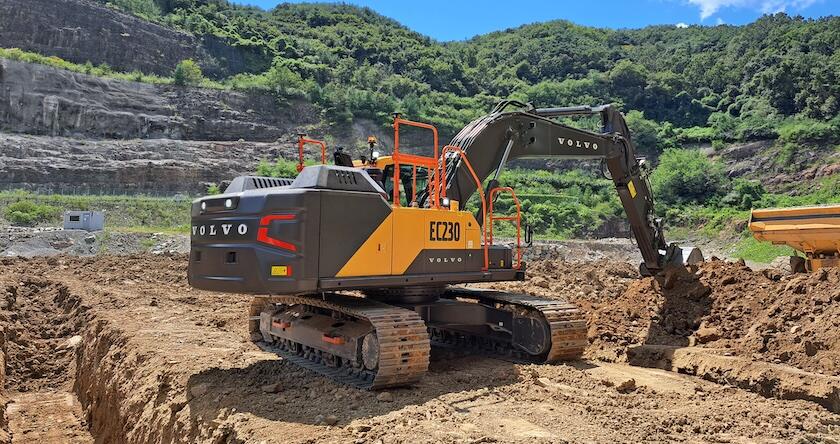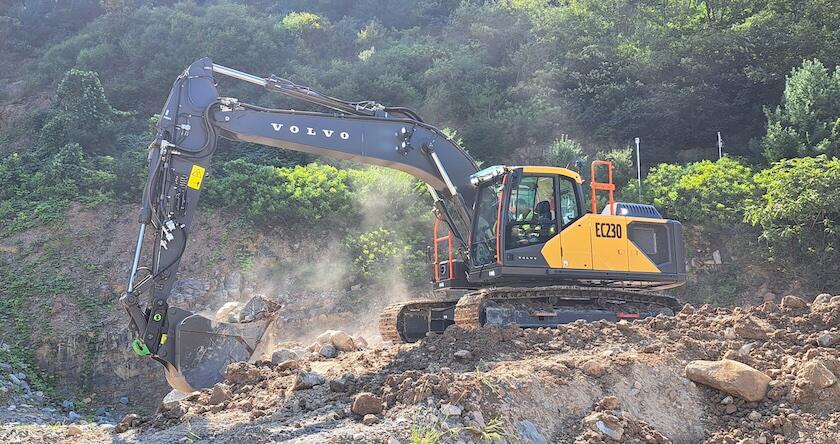Understanding Excavator Hydraulics: Part 1

But before we get into the hydraulic specifics, I know some of you are new to the heavy equipment industries we serve, so I wanted to start by helping you get up to speed with excavator hydraulics in general. If you’re already familiar with the basics, feel free to jump to the section below where I talk more in-depth about our latest excavator hydraulic technologies.
Key Takeaways
- Understanding the fundamental difference between hydraulic pressure (which provides the excavator's power) and hydraulic flow (which controls its speed) is crucial for effective operation.
- In general, excavator hydraulic systems function by using an engine-powered pump to pressurize fluid, which is then directed through valves and hoses to cylinders and motors to create movement and perform work.
- Volvo's latest excavator series features an innovative electric-over-hydraulic system that enhances performance through on-demand flow management, customizable work modes and increased fuel efficiency.
In Part 2 of this excavator hydraulics series (coming June 2) , I focus more on the differences between pilot controls and electric-over-hydraulic (EH) controls with tips on finessing the way you handle an EH-controlled machine.
Excavator Hydraulics 101
Excavators use hydraulic systems to provide the strong power and exact control needed for construction and mining. At its core, hydraulics is the use of pressurized fluid to generate mechanical force. For excavators, this means translating the power from the engine into fluid movement that drives the boom, arm, attachment and so on.
The first thing you’ll need to understand is the difference between hydraulic fluid pressure and flow. This matters because sometimes you need equal amounts of both, and sometimes you need more of one or the other in certain parts of your excavator for specific tasks.
Pressure controls excavator power:
- Think of pressure as the "muscle" of your excavator. Higher pressure allows your machine to exert more force, which is crucial for tasks like breaking through tough materials, lifting heavy loads or digging in heavy/dense material. As an example, when you're using a hydraulic breaker to demolish concrete, you need high pressure to deliver powerful impacts.
- In simpler terms, more pressure = more force.
Flow controls excavator speeds:
- Flow determines how quickly the hydraulic oil moves through the system, which directly impacts the speed of your excavator's movements.
- Higher flow translates to faster boom, arm and bucket movements, allowing you to complete tasks more quickly. For example, when you're grading or backfilling, you might prioritize higher flow to move material more efficiently.
- In simpler terms, more flow = more speed.
So in essence:
- If you need to lift something very heavy, you need high pressure.
- If you need to move a large amount of dirt quickly, you need high flow.
How Does an Excavator Hydraulic System Work?
- Pump Action: The engine powers hydraulic pumps that pressurize hydraulic fluid.
- Directional Control: Hydraulic fluid flows through hoses and valves, including main control valves, to various actuators.
- Cylinders and Motors: These actuators convert the fluid's energy into motion, whether it’s extending the boom, rotating the cab or driving the machine.
- Precision via Valves: Control valves regulate the fluid flow, allowing operators to perform delicate operations or move heavy loads with precision.
The best excavator hydraulic systems are prized for their efficiency, adaptability and ability to perform multiple tasks simultaneously — like digging, swinging and raising a boom — all thanks to advanced hydraulic circuits.
How Do Volvo Excavator Hydraulics Work?
Our newest series of Volvo excavators take hydraulic performance to a new level with a cutting-edge electric-over-hydraulic system and main control valve (MCV). These upgrades leverage intelligent technology to manage hydraulic flow on demand, resulting in improved productivity, precision and fuel efficiency.

Here are the key functions of the Volvo excavator hydraulic system:
- Summation System: By combining the flow from both hydraulic pumps, we ensure quick cycle times and high productivity, which is ideal for high-demand applications like large-scale earthmoving.
- Priority Functions for Smarter Operations: Our excavator hydraulic system incorporates:
- Boom priority for faster raising during loading or deep excavation
- Arm priority for faster leveling and increased bucket filling during digging
- Swing priority to optimize simultaneous swing and digging operations, crucial for tasks like trenching or foundation work
- Regeneration System: This innovative feature prevents cavitation — a loss of pressure that can occur in traditional hydraulic systems — and redirects fluid to other simultaneous movements, maximizing your productivity and ensuring smooth operation.
- Power Boost and Holding Valves: Increased digging and lifting forces enhance machine capability while holding valves prevent unintended movement, providing stability and more confidence for your operators.
- Anti-Rupture Valves: These valves are critical safety components that prevent uncontrolled cylinder movement in the event of a hose rupture. By restricting the flow of hydraulic fluid out of the cylinder, they hold the boom, arm and attachment in position, significantly reducing the risk of accidents and damage.
A Step Ahead: Volvo Electric-Over-Hydraulic Precision
What truly differentiates Volvo excavator hydraulics is our electric-over-hydraulic system, which offers excellent control and efficiency:
- Fuel Savings and Performance Gains: Owners can expect up to 15% better fuel efficiency compared to previous models. Features like a smart cooling system and engine speed regulation for higher torque at lower RPMs combine to deliver more work with less energy.
- Customizable Work Modes: With 10 excavator work mode settings, you can tailor hydraulic response to the task, from heavy lifting to fine grading.
- Enhanced Machine Control: The system enables smooth and precise operation of the boom, arm and attachment, along with shock reduction to minimize load spillage.
Our approach here at Volvo emphasizes integrated intelligence and operator-centric functionality. For example, some manufacturers rely on traditional hydraulic setups that require constant fluid flow (pilot controls), which can waste energy and increase fuel consumption. Our on-demand flow system, though, only activates hydraulic power when needed, improving both productivity and efficiency.

Understanding how excavator hydraulic systems work is vital — and knowing the differences between the technologies offered by the different manufacturers can help you select the best machine to get the work done at the lowest possible cost. That’s why we continue to focus on integrating power, precision and efficiency into every Volvo excavator hydraulic technology we develop.
To get a walkaround of our latest excavator series — including highlights of our electric-over-hydraulic technology — check out this video. If you’d like an in-person walkaround to see it all up close, I recommend reaching out to your nearest Volvo dealer and they can show you the ins and outs.
And don’t forget to check out Part 2 of this excavator hydraulic series where I provide details on the differences between pilot controls and EH controls with a few operating pointers.
Danny Freeman
Sales Training and Product Support Manager
Before working for Volvo, Danny began his career within his family construction business. Currently, he’s a sales training and product support manager with several decades of construction and demolition experience.

